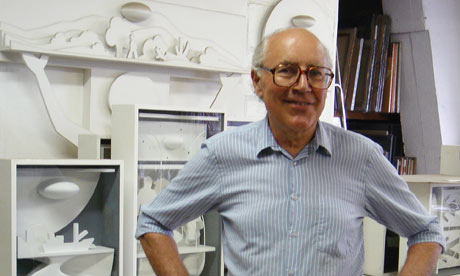Michael Buhler obituary
Artist respected and admired for the sophistication and originality of his work
- guardian.co.uk, Wednesday 9 December 2009 18.51 GMT
- Article history

Gentle wit and humour ... Michael Buhler in his studio last year
Michael Buhler, who has died aged 69, was an artist all too typical of his generation in that he was obliged to earn a living by teaching his craft. Far less well-known as a painter than he deserved to be, he nevertheless showed regularly, from solo displays with the New Art Centre, London, in the 1960s to England & Co only last year, and he was a longstanding member of the London Group, the artists' exhibiting society. He was respected and admired by his peers, not just for his personal commitment as an artist, but for the evident consistency, originality and sophistication of his work. A rare quality of gentle wit and humour, in its quiet observation of the human condition, gave it a particular savour.
As a teacher, principally at Colchester School of Art, Essex, where he taught for many years, and then at the City and Guilds school in Kennington, south-east London, Michael was no less remarkable. He will be long remembered with gratitude and affection by colleagues and students alike, for he applied his marked gift for teaching to the full scope of his wonderfully miscellaneous interests. His methods could be somewhat singular – one wayward student, given to wandering away rather than addressing the pictorial problems at hand, found himself roped to his chair.
Michael was born in London, the only son of the first marriage of Robert Buhler, himself a distinguished painter, a royal academician, a long-time member of staff of the painting school at the Royal College of Art (where he taught his son) and a pillar of the Chelsea Arts Club. Michael was sent first to the Hampshire school in Chelsea, then to Betteshanger in Kent, and finally to Bryanston in Dorset. There, in the art master's flourishing department – a rare thing in the public schools of those days – his innate talent was encouraged and developed.
It was while he was at Bryanston that his parents' marriage broke up. He later recalled waiting on the steps where the boys would greet their parents as they rolled up for speech day in assorted Armstrong Siddeleys and Lagondas, he dreading the arrival of the station taxi, from which his father would emerge, already well set up for the day, along with his friend of the moment. Even into the 1960s, the bailiffs were no strangers to the various houses his father took on, with patches on the walls where paintings had been, and ominous gaps among the furniture. Meanwhile his mother, Eve, had married a diplomat, and long holidays in Argentina brought a welcome change of scene.
In many ways it seemed that Michael's personal life would never be truly settled. For all his great gift for friendship, his first marriage, to the journalist and biographer Georgina Howell, ended in divorce, while his second, to Monika Veriopoulos, a painter who had been his student at the City and Guilds, though loving and enduring, was unusual for the extended periods through which they lived apart.
From Bryanston, Michael went on to the Royal College of Art. To be not only the son of a painter, but to be taught by him too, is not always easy, and while Michael shared with his father a natural subtlety and delicacy of touch, he almost immediately sought to distance himself from him in manner and approach. With pop art and hard-edge colour-field painting current at the time, his solution was to develop an amalgam of the two, expressed at first in terms of crisp and colourful landscape, abstracted to a degree, and then increasingly in terms of a highly stylised and simplified narrative figuration, set upon the many themes that engrossed him: love and courtship; tourists; costume; sex, of course; fashion; night scenes and neon lights; and, above all, flying saucers. He also often made layered boxes, representing an upper- and an underworld. It was an approach, and a resolution of a personal dilemma as an artist, that would sustain him throughout his life.
Those themes and subjects in his paintings were a reflection of a truly engaged and most engaging nature. His enthusiasms were as boundless as they were enduring. He was fascinated by comics, in particular Tintin, whose open and earnest curiosity oddly matched his own. He gathered an enormous collection of tin and clockwork toys of museum quality, now intended for the Museum of Childhood in Bethnal Green, east London. His lifelong belief in UFOs, extraterrestrials and worlds beyond faded more into hope in his later years.
But it is Michael himself who will be remembered, in his Fair Isle pullover, tweed coat and a tie from a collection that remains the envy of many. His graphic output was unquenchable, and no old friend now lacks a clutch of thank-you postcards, overflowing with affectionately ribald sentiment and fun.
One particular friend remembers him in the 1980s at the Berry Street studios in Clerkenwell, where they both had spaces. The communal phone was in the corridor, and "he would frequently be seen there doodling on the wall while he talked to one or other of his beautiful girlfriends. All the various chips and marks on the wall were transformed into a wondrous procession of arched cats, grinning dogs and art world luminaries."
Diagnosed with cancer of the bone marrow some four years ago, Michael died of cardiac failure brought on by his illness. He is survived by Georgina and their son Thomas, and by Monika, who cared for him devotedly throughout his illness, and their daughter Alexandra.
• Michael Robert Buhler, artist and teacher, born 13 June 1940; died 30 October 2009
- guardian.co.uk © Guardian News and Media Limited 2009
No comments:
Post a Comment